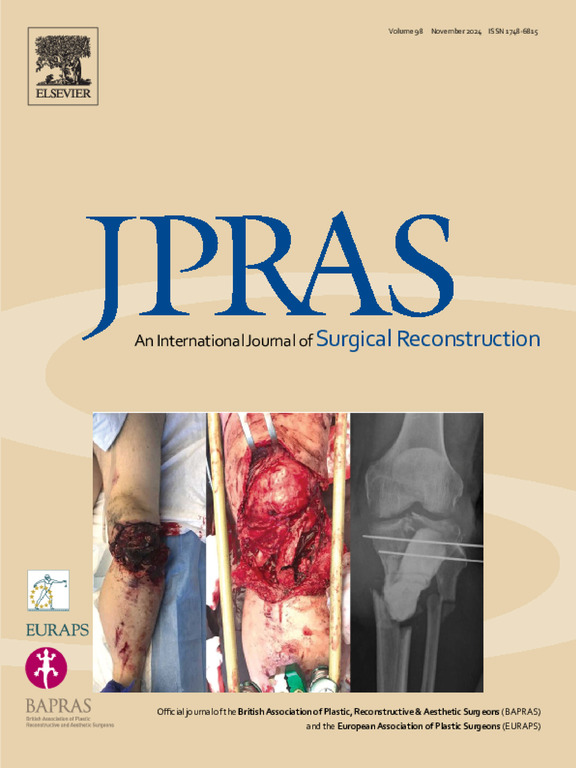美容手术后身体形象的时间满意度模式:系统回顾与元分析
IF 2.4
3区 医学
Q2 SURGERY
Journal of Plastic Reconstructive and Aesthetic Surgery
Pub Date : 2025-08-21
DOI:10.1016/j.bjps.2025.07.044
引用次数: 0
摘要
背景了解整容手术后身体形象满意度的变化对心理适应和临床实践至关重要。我们系统地回顾和荟萃分析了美容手术后随时间推移的满意度趋势,以阐明心理适应过程。方法检索PubMed、Web of Science和PsycINFO(2010-2024),检索报告术后多个时间点满意度的研究。本综述注册号为PROSPERO CRD420251054218。随机效应荟萃分析综合了满意度,并按程序类型进行了亚组分析。元回归探讨了心理和人口统计学的预测因素。结果27项研究(N=4823例)患者满意度随时间的推移迅速上升,分别为:1个月时71.4%、3个月时82.6%、6个月时87.2%、12个月时91.5%、24个月时93.8%。心理筛查(β=0.134, p<0.001)和年龄(β=0.012/年,p<0.001)正预测满意度,而体重指数(β= - 0.024/单位,p=0.001)和翻修手术(β= - 0.187, p<0.001)负预测满意度。乳房手术满意度最高(12个月时为93.2%),而隆鼻手术满意度最低(12个月时为86.3%)。结论美容手术后的身体形象满意度遵循可预测的适应模式,符合享乐适应理论。最初的快速增加反映了术后立即缓解,而随后的稳定则代表了自我概念的整合。结果支持心理筛查和对最佳结果的现实期望设定。局限性包括测量工具的异质性、发表偏倚和超过24个月的有限长期随访。本文章由计算机程序翻译,如有差异,请以英文原文为准。
Temporal satisfaction patterns in body image after aesthetic surgery: A systematic review and meta-analysis
Background
Understanding how body image satisfaction evolves following aesthetic surgery is crucial for psychological adaptation and clinical practice. We systematically reviewed and meta-analyzed satisfaction trends over time following aesthetic surgery to elucidate the psychological adaptation process.
Methods
We searched PubMed, Web of Science, and PsycINFO (2010–2024) for studies reporting satisfaction at multiple post-operative time points. This review was registered on PROSPERO CRD420251054218. Random-effects meta-analysis synthesized satisfaction rates, with subgroup analyses by procedure type. Meta-regression explored psychological and demographic predictors.
Results
Twenty-seven studies (N=4823 patients) demonstrated satisfaction that increased rapidly then plateaued over time: 71.4% at 1 month, 82.6% at 3 months, 87.2% at 6 months, 91.5% at 12 months, and 93.8% at 24 months. Psychological screening (β=0.134, p<0.001) and age (β=0.012/year, p<0.001) positively predicted satisfaction, while body mass index (β=−0.024/unit, p=0.001) and revision surgery (β=−0.187, p<0.001) negatively predicted outcomes. Breast procedures showed the highest satisfaction (93.2% at 12 months), while rhinoplasty showed the lowest (86.3% at 12 months).
Conclusions
Body image satisfaction following aesthetic surgery follows predictable adaptation patterns consistent with hedonic adaptation theory. The initial rapid increase reflects immediate post-operative relief, while subsequent stabilization represents integration into self-concept. Results support psychological screening and realistic expectation-setting for optimal outcomes. Limitations include heterogeneous measurement tools, publication bias, and limited long-term follow-up beyond 24 months.
求助全文
通过发布文献求助,成功后即可免费获取论文全文。
去求助
来源期刊
CiteScore
3.10
自引率
11.10%
发文量
578
审稿时长
3.5 months
期刊介绍:
JPRAS An International Journal of Surgical Reconstruction is one of the world''s leading international journals, covering all the reconstructive and aesthetic aspects of plastic surgery.
The journal presents the latest surgical procedures with audit and outcome studies of new and established techniques in plastic surgery including: cleft lip and palate and other heads and neck surgery, hand surgery, lower limb trauma, burns, skin cancer, breast surgery and aesthetic surgery.

 求助内容:
求助内容: 应助结果提醒方式:
应助结果提醒方式:


